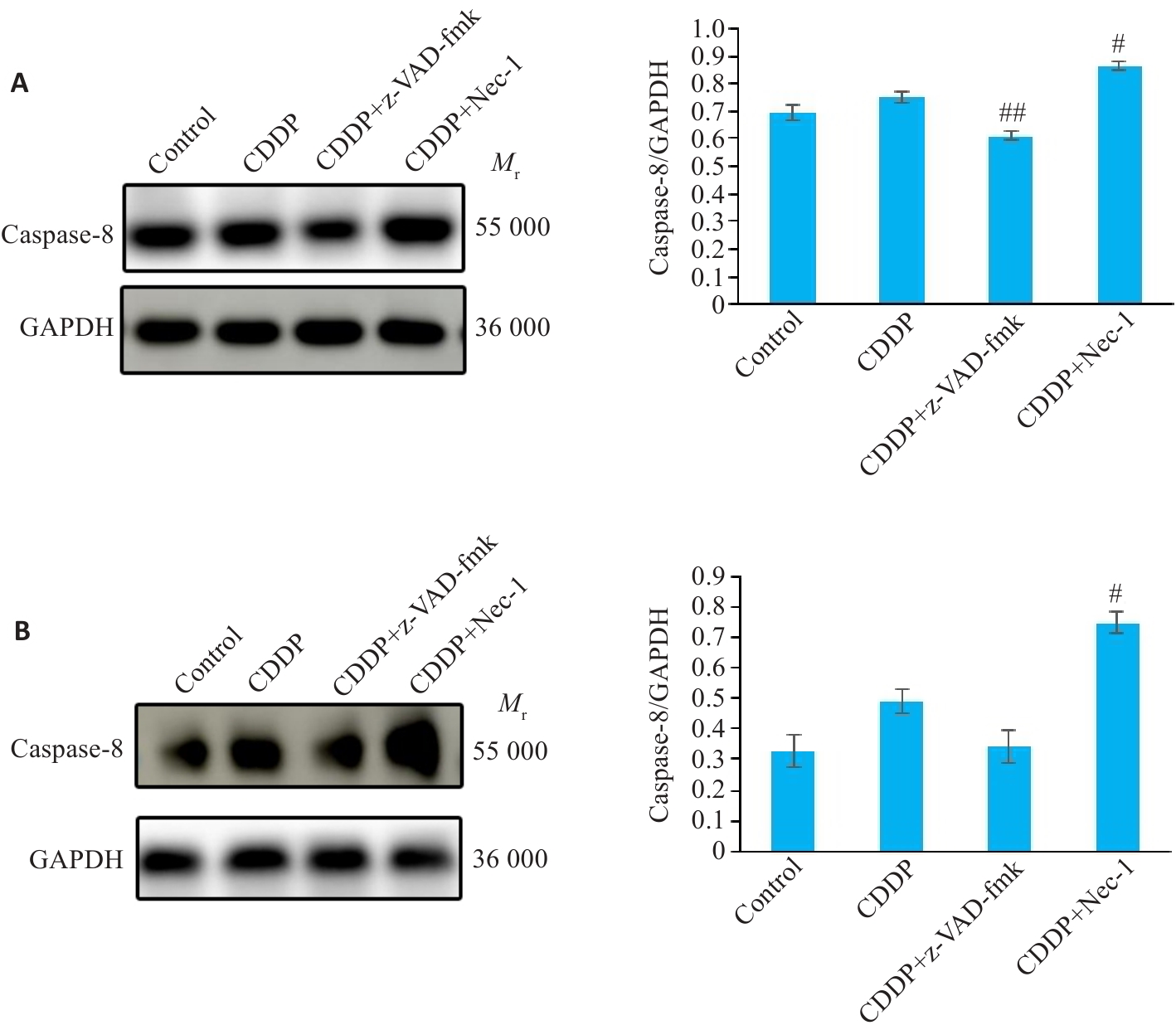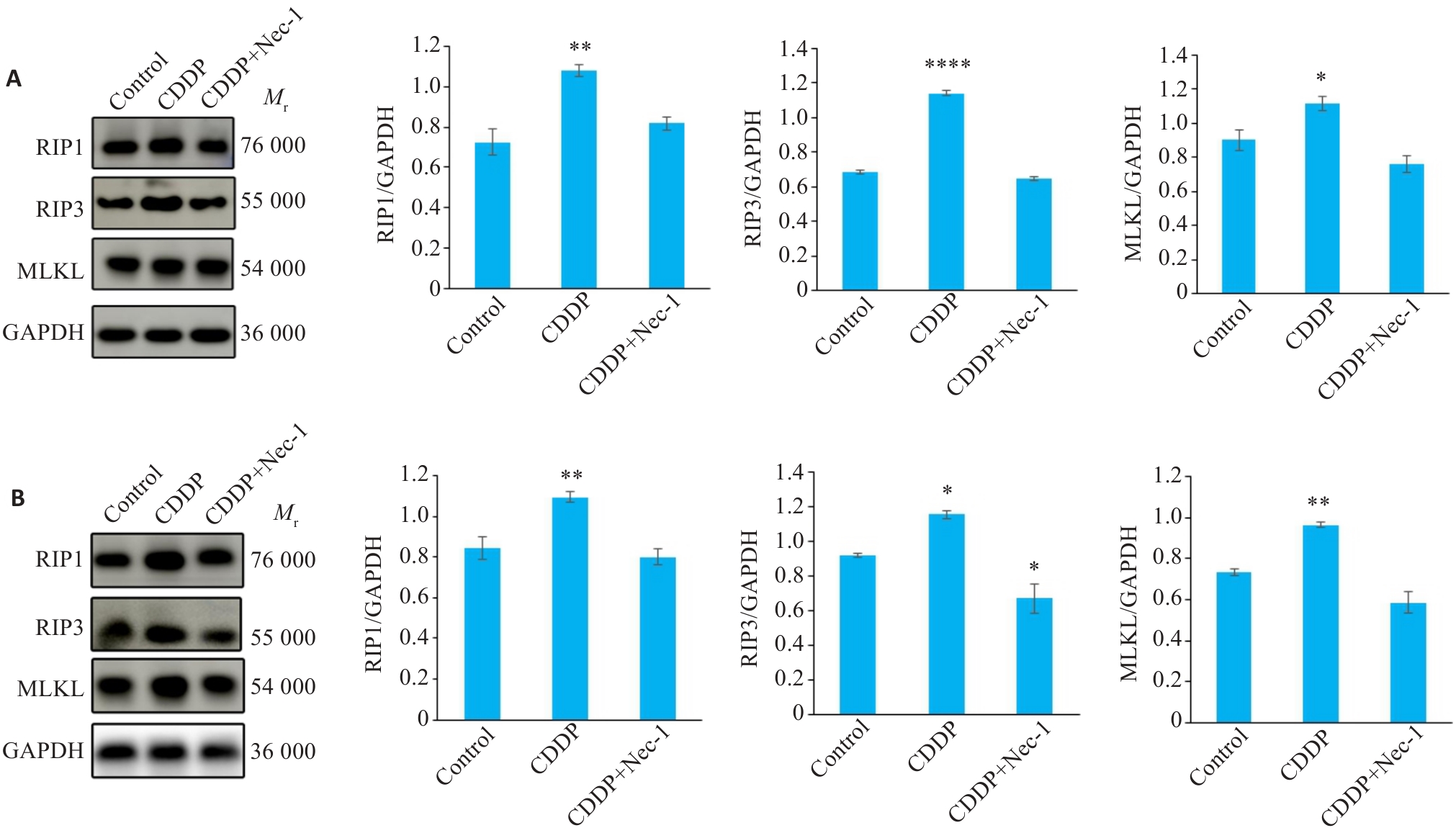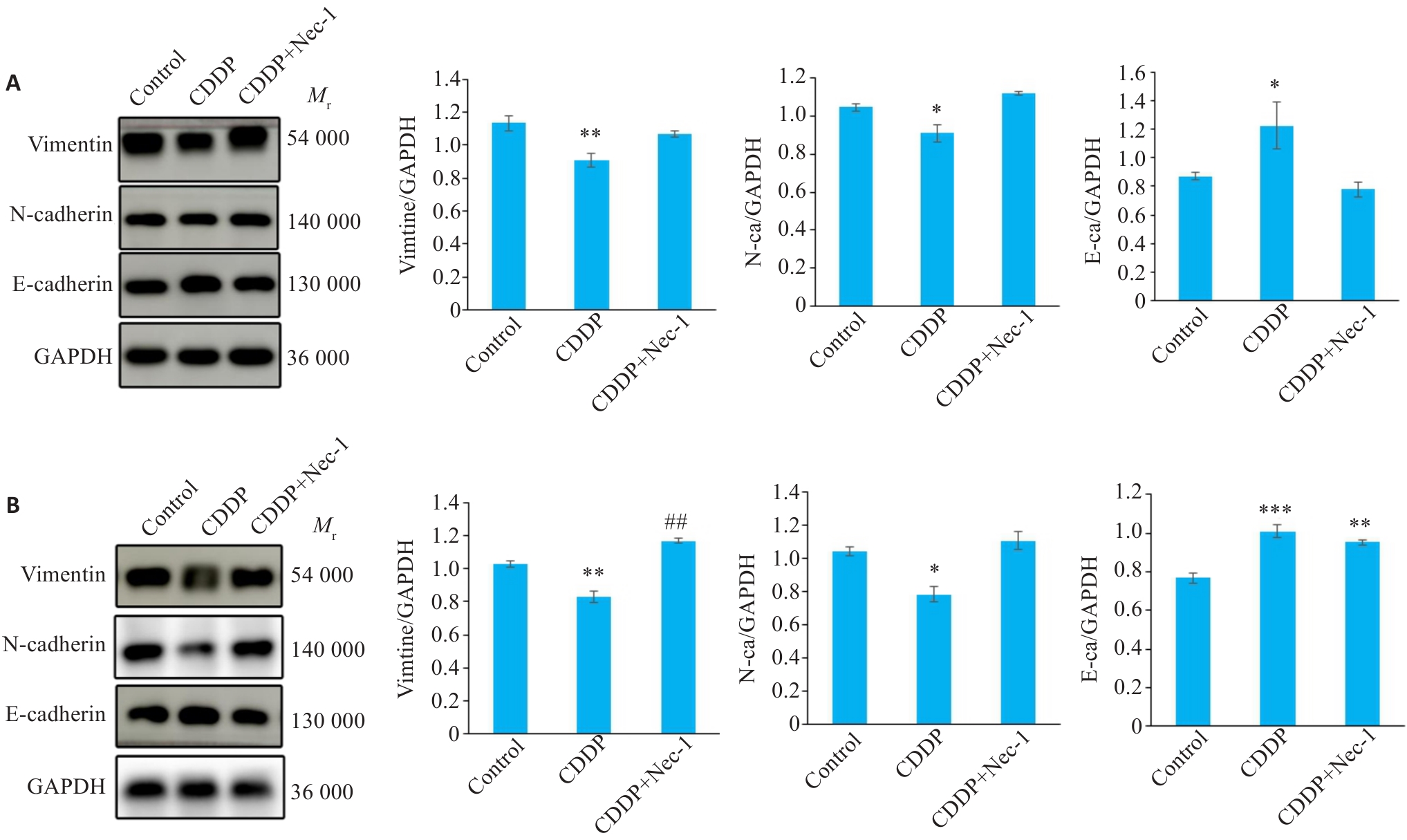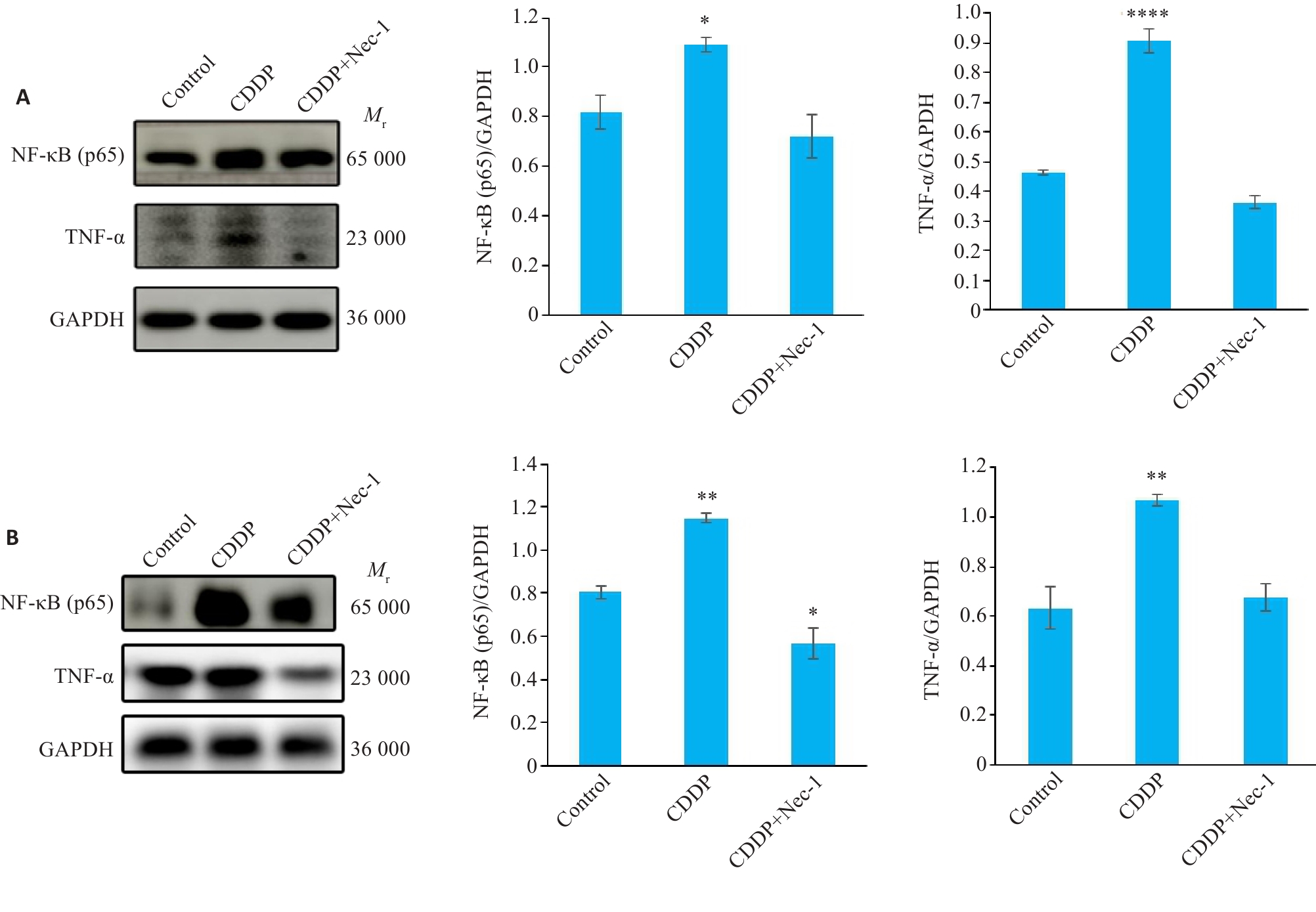Journal of Southern Medical University ›› 2024, Vol. 44 ›› Issue (10): 1947-1954.doi: 10.12122/j.issn.1673-4254.2024.10.13
Hongxiao WANG1( ), Detao TAO2,3(
), Detao TAO2,3( ), Junjie MA1, Donglin ZHANG1,3, Zuoyuan SHEN1, Chao DENG1,3(
), Junjie MA1, Donglin ZHANG1,3, Zuoyuan SHEN1, Chao DENG1,3( ), Jingping ZHOU1,3(
), Jingping ZHOU1,3( )
)
Received:2024-07-25
Online:2024-10-20
Published:2024-10-31
Contact:
Chao DENG, Jingping ZHOU
E-mail:1492673419@qq.com;taodetao@wnmc.edu.cn;20120015@wnmc.edu.cn;19950008@wnmc.edu.cn
Hongxiao WANG, Detao TAO, Junjie MA, Donglin ZHANG, Zuoyuan SHEN, Chao DENG, Jingping ZHOU. Cisplatin promotes TNF‑α autocrine to trigger RIP1/RIP3/MLKL-dependent necroptosis of human head and neck squamous cell carcinoma cells[J]. Journal of Southern Medical University, 2024, 44(10): 1947-1954.
Add to citation manager EndNote|Ris|BibTeX
URL: https://www.j-smu.com/EN/10.12122/j.issn.1673-4254.2024.10.13

Fig.2 Western blotting for detecting expression of caspase-8 protein in HN4 (A) and SCC4 cells (B) with different treatments. ##P<0.01, #P<0.05 vs CDDP group.

Fig.3 Western blotting for detecting protein expression levels of RIP1, RIP3, and MLKL in HN4 (A) and SCC4 cells (B) with cisplatin-induced necroptosis. *P<0.05, **P<0.01, ****P<0.0001 vs control group.

Fig.4 Western blotting for detecting protein expressions of epithelial-mesenchymal transition (EMT) marker proteins in HN4 (A) and SCC4 cells (B) with cisplatin-induced necroptosis. *P<0.05, **P<0.01, ***P<0.001 vs control group. ##P<0.01 vs CDDP group.

Fig.6 Western blotting for detecting expressions of TNF-α and NF-κB (p65) proteins in HN4 (A) and SCC4 cells (B) with cisplatin-induced necroptosis. *P<0.05, **P<0.01, ****P<0.0001 vs control group.
| 1 | Mohapatra P, Mohanty S, Ansari SA, et al. CMTM6 attenuates cisplatin-induced cell death in OSCC by regulating AKT/c-Myc-driven ribosome biogenesis[J]. FASEB J, 2022, 36(10): e22566. |
| 2 | Feng YY, Cao XD, Zhao B, et al. Nitrate increases cisplatin chemosensitivity of oral squamous cell carcinoma via REDD1/AKT signaling pathway[J]. Sci China Life Sci, 2021, 64(11): 1814-28. |
| 3 | Sasaya T, Kubo T, Murata K, et al. Cisplatin-induced HSF1-HSP90 axis enhances the expression of functional PD-L1 in oral squamous cell carcinoma[J]. Cancer Med, 2023, 12(4): 4605-15. |
| 4 | Choi HS, Kim YK, Yun PY. Cisplatin plus cetuximab inhibits cisplatin-resistant human oral squamous cell carcinoma cell migration and proliferation but does not enhance apoptosis[J]. Int J Mol Sci, 2021, 22(15): 8167. |
| 5 | Tang DL, Kang R, Berghe TV, et al. The molecular machinery of regulated cell death[J]. Cell Res, 2019, 29(5): 347-64. |
| 6 | Miao YD, Quan WX, Dong X, et al. A bibliometric analysis of ferroptosis, necroptosis, pyroptosis, and cuproptosis in cancer from 2012 to 2022[J]. Cell Death Discov, 2023, 9(1): 129. |
| 7 | Liu ZG, Jiao DL. Necroptosis, tumor necrosis and tumorigenesis[J]. Cell Stress, 2019, 4(1): 1-8. |
| 8 | Gong YT, Fan ZY, Luo GP, et al. The role of necroptosis in cancer biology and therapy[J]. Mol Cancer, 2019, 18(1): 100. |
| 9 | 王 芳, 李开颖, 蔡振宇. 程序性细胞死亡与肿瘤[J]. 中国细胞生物学学报, 2022, 44(4): 539-50. |
| 10 | Zhu XD, Li SL. Ferroptosis, necroptosis, and pyroptosis in gastrointestinal cancers: the chief culprits of tumor progression and drug resistance[J]. Adv Sci, 2023, 10(26): e2300824. |
| 11 | Liu L, Huang L, Chen WZ, et al. Comprehensive analysis of necroptosis-related long noncoding RNA immune infiltration and prediction of prognosis in patients with colon cancer[J]. Front Mol Biosci, 2022, 9: 811269. |
| 12 | Wang L, Hu CH, Zhao Y, et al. Novel smac mimetic ASTX660 (Tolinapant) and TNF‑α synergistically induce necroptosis in bladder cancer cells in vitro upon apoptosis inhibition[J]. Biochem Biophys Res Commun, 2022, 602: 8-14. |
| 13 | Xu Y, Lin ZW, Zhao N, et al. Receptor interactive protein kinase 3 promotes Cisplatin-triggered necrosis in apoptosis-resistant esophageal squamous cell carcinoma cells[J]. PLoS One, 2014, 9(6): e100127. |
| 14 | Chen J, Shao B, Wang J, et al. Chlorpyrifos caused necroptosis via MAPK/NF‑κB/TNF‑α pathway in common carp (Cyprinus carpio L.) gills[J]. Comp Biochem Physiol C Toxicol Pharmacol, 2021, 249: 109126. |
| 15 | Chen DS, Tong JS, Yang LH, et al. PUMA amplifies necroptosis signaling by activating cytosolic DNA sensors[J]. Proc Natl Acad Sci U S A, 2018, 115(15): 3930-5. |
| 16 | 张一鸣. LncRNAWSF27/miRNA: 1696调控GPX3参与细胞程序性坏死介导的鸡缺硒性肠炎的研究[D]. 哈尔滨: 东北农业大学, 2023. |
| 17 | Ofengeim D, Yuan JY. Regulation of RIP1 kinase signalling at the crossroads of inflammation and cell death[J]. Nat Rev Mol Cell Biol, 2013, 14(11): 727-36. |
| 18 | Cai HT, Lv MM, Wang TT. PANoptosis in cancer, the triangle of cell death[J]. Cancer Med, 2023, 12(24): 22206-23. |
| 19 | Krishnan RP, Pandiar D, Ramani P, et al. Necroptosis in human cancers with special emphasis on oral squamous cell carcinoma[J]. J Stomatol Oral Maxillofac Surg, 2023, 124(6S): 101565. |
| 20 | Wu XQ, Nagy LE, Gautheron J. Mediators of necroptosis: from cell death to metabolic regulation[J]. EMBO Mol Med, 2024, 16(2): 219-37. |
| 21 | Duan YW, Li QY, Zhou YH, et al. Activation of the TNF‑α-necroptosis pathway in parvalbumin-expressing interneurons of the anterior cingulate cortex contributes to neuropathic pain[J]. Int J Mol Sci, 2023, 24(20): 15454. |
| 22 | Lee CS, Hwang G, Nam YW, et al. IKK-mediated TRAF6 and RIPK1 interaction stifles cell death complex assembly leading to the suppression of TNF‑α‑induced cell death[J]. Cell Death Differ, 2023, 30(6): 1575-84. |
| 23 | Luo R, Onyshchenko K, Wang LQ, et al. Necroptosis-dependent immunogenicity of cisplatin: implications for enhancing the radiation-induced abscopal effect[J]. Clin Cancer Res, 2023, 29(3): 667-83. |
| 24 | Wang S, Liu XY, Liu Y. Hydrogen sulfide protects from acute kidney injury via attenuating inflammation activated by necroptosis in dogs[J]. J Vet Sci, 2022, 23(5): e72. |
| 25 | Sulkshane P, Teni T. BH3 mimetic Obatoclax (GX15-070) mediates mitochondrial stress predominantly via MCL-1 inhibition and induces autophagy-dependent necroptosis in human oral cancer cells[J]. Oncotarget, 2017, 8(36): 60060-79. |
| 26 | Basit F, Cristofanon S, Fulda S. Obatoclax (GX15-070) triggers necroptosis by promoting the assembly of the necrosome on autophagosomal membranes[J]. Cell Death Differ, 2013, 20(9): 1161-73. |
| 27 | Yuan TM, Liang RY, Chueh PJ, et al. Role of ribophorin II in the response to anticancer drugs in gastric cancer cell lines[J]. Oncol Lett, 2015, 9(4): 1861-8. |
| 28 | Huang YC, Yuan TM, Liu BH, et al. Capsaicin potentiates anticancer drug efficacy through autophagy-mediated ribophorin II downregulation and necroptosis in oral squamous cell carcinoma cells[J]. Front Pharmacol, 2021, 12: 676813. |
| 29 | Uzunparmak B, Gao M, Lindemann A, et al. Caspase-8 loss radiosensitizes head and neck squamous cell carcinoma to SMAC mimetic-induced necroptosis[J]. JCI Insight, 2020, 5(23): e139837. |
| 30 | Huang K, Gu XT, Xu HM, et al. Prognostic value of necroptosis-related genes signature in oral squamous cell carcinoma[J]. Cancers, 2023, 15(18): 4539. |
| 31 | Seo J, Nam YW, Kim S, et al. Necroptosis molecular mechanisms: recent findings regarding novel necroptosis regulators[J]. Exp Mol Med, 2021, 53(6): 1007-17. |
| 32 | Yun HM, Park JE, Lee JY, et al. Latifolin, a natural flavonoid, isolated from the heartwood of Dalbergia odorifera induces bioactivities through apoptosis, autophagy, and necroptosis in human oral squamous cell carcinoma[J]. Int J Mol Sci, 2022, 23(21): 13629. |
| Viewed | ||||||
|
Full text |
|
|||||
|
Abstract |
|
|||||